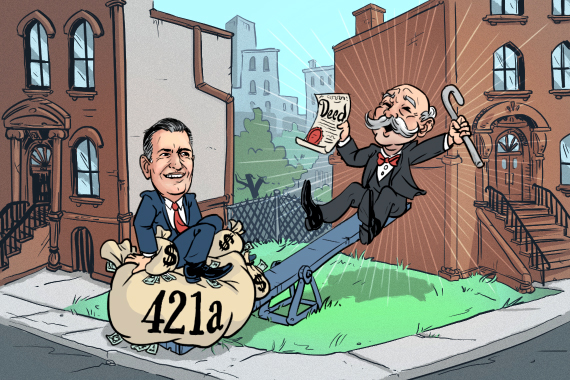Trending
Meet 421a’s real beneficiaries: Landowners
Research suggests tax program drives up land prices

When state lawmakers in June agreed to an overhaul of the 421a tax abatement program, Gov. Andrew Cuomo called the revisions the “best rent reform package in history.” Mayor Bill de Blasio even called them a “game-changer.” But the overhaul could also be, according to several studies, a giant boon to landowners.
Programs like 421a push up land prices in the long run, enriching landowners at taxpayers’ expense. This raises questions about who will really benefit from a program the mayor hailed as ending “giveaways” to the real estate industry.
NYU’s Furman Center published a report this month that argued proposed changes to 421a would make rental development more profitable and thus encourage it. Somewhat buried in the report is the connection between 421a and land prices.
Letting the 421a tax credit expire would likely drive down land prices in parts of the city, such as Downtown Brooklyn and Williamsburg, where the program is heavily used, the report notes. In areas “where both rental and condominium developments are using the 421-a program, the loss of the 421-a exemption would reduce the amount that residential developers would be willing to pay for the land and so land prices may fall unless developers of commercial offices or other allowable uses are willing to pay the original prices,” the report notes.
How incentives drive up land prices
If development sans the subsidy is less profitable, fewer developers (who tend to seek certain returns) will be willing to pay current market prices for land. This fall in demand will push down land prices. In the short term, falling land prices would lead some landowners to hold on to their lots, stymying development. “In the medium and long term,” however, “as landowners adjust their expectations of the value of development parcels downward or as market rents rise, the pace of development could resume,” the report notes. Over time, development could hit a similar pace, but at lower land prices.
Adding subsidies, on the other hand, will push up land prices. If more subsidies make development more profitable, more developers will want in on the action. In a more or less free and efficient market, the added demand for development sites will push up land prices until developers’ returns are back to where they were before the subsidy was expanded. Jason Barr, an economics professor at Rutgers University, compared the dynamic to a seesaw: the more development subsidies you pile on one end, the higher land prices rise on the other (see illustration).
In the long run, the benefits of the 421a incentive will be neutralized by the rise in land prices. The real beneficiaries, then, are landowners, who can sell their plot for more on the back of government policy. So in theory at least, subsidies like 421a don’t actually influence development activity in the long run. Their main impact is on land prices.
Other studies support this observation. In a 1984 paper examining inclusionary housing, (a program that requires developers to create or preserve affordable housing units) Alan Mallach, a senior fellow at the National Housing Institute, found that “in the long run … most of the costs will be passed backward to the owners of land.” In other words: in the short run developers carry the added cost of having to keep more units affordable, but in the long run land prices fall, meaning landowners carry the ultimate burden.
A 2009 paper by Jenny Schuetz of the University of Southern California, Rachel Meltzer of the New School and Vicki Been, then an NYU professor and now the Commissioner of the New York City Department of Housing Preservation and Development, found that while inclusionary housing slightly decreased development in Boston, it had no impact on the pace of development in San Francisco.
“Any incentives offered by a community would reduce the degree of land price reductions,” Rick Jacobus, principal of Street Level Urban Impact Advisors, wrote in a 2015 Lincoln Institute report. In other words: benefits like 421a simply push up land prices in the long run. And since the proposed changes to the program may make rental development more profitable in many pockets of the city, according to the NYU report, they could push land prices there even higher.
De Blasio’s dilemma
Does this mean the centerpiece program of Bill de Blasio’s administration is merely a giveaway to landowners that doesn’t actually encourage housing development? In reality, the picture is more complicated.
Without 421a, some neighborhoods would languish without any development, “even if land prices were zero,” said Mark Willis, one of the authors of the NYU report, pointing to neighborhoods like Bedford-Stuyvesant or Astoria where rents are comparatively low. “By giving 421a incentives you allow development to happen.” His point was echoed at a recent conference by the Related Cos.’ Stephen Ross, who said that if 421a were to expire, “zero units of rental housing” would be built.
And in parts of Manhattan or Brooklyn where rents are higher, removing the 421a incentive would likely lead even more rental developers to switch to condos, reducing the stock of affordable housing (an argument that REBNY executives can make in their sleep). A potential solution to this dilemma would be raising a corresponding tax on condo construction to make rentals competitive again, but such a tax hike has virtually no chance of passing the Republican- and real estate-dominated state Legislature in Albany. The 421a amendments currently on the table make condo developments ineligible for the subsidies, which could put slight downward pressure on land prices in condo-dominated neighborhoods like Central Park South.
Most importantly, while land prices may adjust in the long run, removing 421a subsidies could cause serious disruption in the interim, the NYU report found. This would put the de Blasio’s administration’s goal of 80,000 new affordable units by 2025 out of reach.
In the current political climate, if the city wants to create affordable housing on its promised timeline, it appears to have little choice but to effectively subsidize unproductive landowners.
Landowners in limbo
Earlier this year, TRD spoke with an active Brooklyn multifamily developer who was scouting for potential sites to buy, but wanted to wait until the fate of 421a was clearer. If the program expires, he said, the price of land would likely fall and he could buy plots more cheaply.
Today, the fate of 421a is still in limbo. The state legislature passed a framework in June that would extend the affordable requirement from 20 percent to 25 or 30 percent of a building’s units in exchange for a longer tax abatement period. But for it to pass, REBNY and labor groups need to agree on whether developers of affordable housing should be required to use union workers. If a final 421a agreement includes the requirement to use union labor, and if that added cost offsets any gains from the expanded subsidy, land prices could fall instead of rise. Related’s Ross said that “there’s really been no movement that I’ve seen” on the union issue.
If they don’t strike a deal by the end of December, the incentive program will expire. Landowners across the city are waiting and watching.





